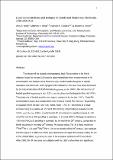| dc.contributor.author | Kelly, Amy E. | |
| dc.contributor.author | Reuer, Matthew K. | |
| dc.contributor.author | Goodkin, Nathalie F. | |
| dc.contributor.author | Boyle, Edward A | |
| dc.date.accessioned | 2011-05-25T14:50:14Z | |
| dc.date.available | 2011-05-25T14:50:14Z | |
| dc.date.issued | 2009-05 | |
| dc.date.submitted | 2009-03 | |
| dc.identifier.issn | 0012-821X | |
| dc.identifier.uri | http://hdl.handle.net/1721.1/63109 | |
| dc.description.abstract | The history of the oceanic anthropogenic lead (Pb) transient in the North Atlantic Ocean for the past 220 yr is documented here from measurements of Pb concentration and isotope ratios from annually-banded corals that grew in coastal seawaters near Bermuda and from seawater samples collected during the last 20 yr of the 20th century. Anthropogenic Pb emissions in this area have been dominated by the industrialization of North America beginning in the 1840s, the introduction of leaded gasoline beginning in the 1920s and its phase-out that began in the mid-1970s. The phase-out of leaded gasoline was largely completed by the late 1990s. Coral Pb concentrations occur at a constant low level of about 5 nmol Pb/mol Ca (~ 15 pmol/kg in seawater) from the late 1700s to ~ 1850. From ~ 1850 to ~ 1900 there is a small increase rising to a plateau at ~ 25 nmol Pb/mol Ca (~ 80 pmol/kg in seawater) in the 1930s until the late 1940s, at which point Pb concentrations rapidly increase to ~ 60 nmol Pb/mol Ca (~ 200 pmol/kg in seawater). In the mid 1970s, Pb began to decline to ~ 25 nmol Pb/Ca (40 pmol/kg in seawater) by the end of the 20th century, comparable to levels occurring in the early 20th century. Pb isotope ratios (Pb I.R.) show maximum 206Pb/207Pb = 1.21 and 208Pb/207Pb = 2.49 in the middle of the 19th century. We conclude that this signal is a reflection of the early dominance of Upper Mississippi Valley Pb ore in the United States, as previously seen in the estuarine sediments of Rhode Island. After 1900, Pb I.R. decrease only slightly until the 1960s when there is a significant local maximum in the 1970s to 206Pb/207Pb = 1.19 and 208Pb/207Pb = 2.45 as low-Pb I.R. sources were phased out in the United States. Then, as US leaded gasoline utilization decreased more rapidly than European Pb gas utilization (which has lower Pb I.R.), western North Atlantic Pb I.R. decreased to 206Pb/207Pb = 1.17 and 208Pb/207Pb = 2.44, their lowest values in the past two centuries. | en_US |
| dc.description.sponsorship | National Science Foundation (U.S.) (NSF Grant OCE-0751409) | en_US |
| dc.description.sponsorship | Kuwait Foundation for the Advancement of Sciences | en_US |
| dc.description.sponsorship | Massachusetts Institute of Technology | en_US |
| dc.language.iso | en_US | |
| dc.publisher | Elsevier B.V. | en_US |
| dc.relation.isversionof | http://dx.doi.org/10.1016/j.epsl.2009.03.045 | en_US |
| dc.rights | Creative Commons Attribution-Noncommercial-Share Alike 3.0 | en_US |
| dc.rights.uri | http://creativecommons.org/licenses/by-nc-sa/3.0/ | en_US |
| dc.source | Prof. Boyle via Anne Graham | en_US |
| dc.title | Lead Concentrations and Isotopes in Corals and Water near Bermuda, 1780-2000 A.D. | en_US |
| dc.type | Article | en_US |
| dc.identifier.citation | Kelly, Amy E. et al. “Lead Concentrations and Isotopes in Corals and Water Near Bermuda, 1780-2000.” Earth and Planetary Science Letters 283.1-4 (2009) : 93-100. | en_US |
| dc.contributor.department | Massachusetts Institute of Technology. Department of Earth, Atmospheric, and Planetary Sciences | en_US |
| dc.contributor.approver | Boyle, Edward A. | |
| dc.contributor.mitauthor | Kelly, Amy E. | |
| dc.contributor.mitauthor | Reuer, Matthew K. | |
| dc.contributor.mitauthor | Goodkin, Nathalie F. | |
| dc.contributor.mitauthor | Boyle, Edward A. | |
| dc.relation.journal | Earth and Planetary Science Letters | en_US |
| dc.eprint.version | Author's final manuscript | en_US |
| dc.type.uri | http://purl.org/eprint/type/JournalArticle | en_US |
| eprint.status | http://purl.org/eprint/status/PeerReviewed | en_US |
| dspace.orderedauthors | Kelly, Amy E.; Reuer, Matthew K.; Goodkin, Nathalie F.; Boyle, Edward A. | en |
| dc.identifier.orcid | https://orcid.org/0000-0002-6394-1866 | |
| mit.license | OPEN_ACCESS_POLICY | en_US |
| mit.metadata.status | Complete | |
